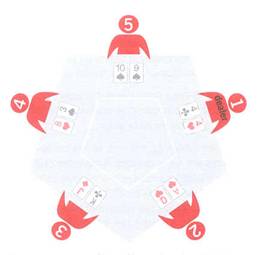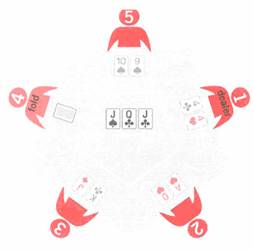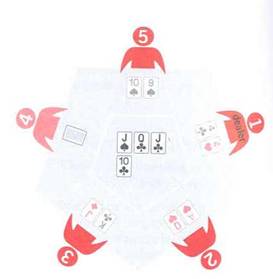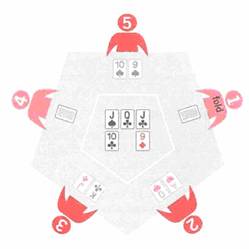EXAMPLE TEXAS HOLDEM BASIC HAND
The stake limits are:
- Small blind – one chip
- Big blind – three chip
- Minimum bet or raise – three chips
- Maximum first round bet or raise- ten chips.
- Maximum bet or raise in other rounds – 2- chips.
First betting interval
Player 1 is ‘on the button’ , player 2 is small blind and Player 3 big blind.
- Player 4 is first to speak. He has a very poor hand and folds immediately.
- Player 5 has a reasonably good hand, 10,9, suited (i.e. of the same suit) and calls.
- Player 1’s small pair is also reasonable. He calls.
- Player 2 with A, Q suited, has an excellent hand. Having put in one chip as small blind, he adds two to call, and another three to raise.
- Player 3 and 5 decide to call, as doe’s player 1. Four players are left and there are 24 chips in the pot.

1ST BETTING INTERVAL Player 2’s excellent hand leads him to bet positively straight away.
Second betting interval
The flop is a splendid turn-up for player 3, who has a trip (three of a kind) of Jacks.
- Player 2 is under the gun, so he speaks first. His hand is now two pairs – Queens and Jacks –but his hopes of a flush have gone. It is not such a good combination as it sounds, since every hand will contain the pair of Jacks, but his two Queens and spare Ace are valuable and he bets three chips, waiting to see how the betting proceeds. He could have checked, which an option is for all players on all rounds after the first, until somebody bets, when the option disappears.
- Player 3 has improved to three Jacks, and has King, Queen, and Jack of clubs as well. He could hardly have a better hand at this stage but decides that merely to call might pay dividends, if other players remain in.
- Player 5 has a double-ended straight (Q, J,10, 9) and three consecutive spades, so he too is happy to stay for three chips.
- Dealer (Player 1), although he has two pairs, Jacks and 4s, is doubtful. He guesses that there must be a hand or two with two pairs around, and he can hardly have the best, since all players have two Jacks, and his two 4s are no good as a second pair. However, he is an optimistic soul, and also calls. Four players are still in and the pot now has 36 chips.

2ND BETTING INTERVAL The flop has done particular favors for players 3 and 5.
Now comes the turn, or fourth street. It is the ♣ 10.
Third betting interval
Strangely enough, the ♣ 10, which makes the community cards look exceptional, is not wildly welcomed by most of the players.
- It does not improve player 2’s hand. He checks.
- Player 3 is happiest. It gives him, K,Q, J, 10 suited, with the possibility of the best poker hand of all, a royal flush. He still has no better than his triple Jacks, but a royal flush would be a hand of a lifetime for him. He decides to put some pressure on by betting 20 chips.
- Player 5’s hand is improved to two pairs – Jacks and 10s. He thinks this I not enough, but on the other hand is reluctant to fold, with a Queen-high straight also possible. Without much confidence he calls with 20 chips.
- The dealer is in a quandary. His two pairs are no good he reckons but a club would give him a flush. On the other hand it might also give another player a flush and if it did so his ♣ 4 would again be the card that decided the outcome. Sensibly he folds.
- Player 2, who had checked, now decides to stay in by calling with 20 chips. There are three players in for the final round and a pot of 96 chips.

3RD BETTING INTERVAL On the face of it a good card, the turn greatly improves only player 3’s hand.
Fourth betting interval
The illustration below shows the community cards when the last card, the fifth street or river, the ♦ 9, was turned. The whole set of five cards is known as the ‘board’.
When the board is displayed, players should work out which two cards could be added to it to make the best hand possible. That hand is known as ‘the nuts’, and a player who holds it is unbeatable. The best possible hand in this example is a royal flush, needing the ♣ A, ♣ K in the hole. Nobody has both of these cards. When a pair is showing on the board, a full house is always a good possibility – in this case Queens up would be the best. A flush is likely – it needs only two clubs in the hole. A straight is very likely – a King or 8 in the hole would provide it.

4TH BETTING INTERVAL Player 3’s straight outranks the other players’ sets of two pairs and he takes the pot.
- Player 2 has been a little unlucky. Two pairs, Queens and Jacks, is less than he would have hoped for with those hole-cards. In view of what hands are possible, he checks.
- Player 3 has got his straight, but is that enough? He checks, too.
- Player 5 reckons he has no chance with his two pairs, Jacks and 10s, after the heavy betting. It costs him nothing to check, so the three hands compete in a showdown.
Player 3’s straight takes the pot of 96 chips. As he contributed 29 himself, his profit is 67 chips.
In Holdem the first two cards, the face-down ones, are the important ones. All the cards in the board are available to all the players; what separates one player’s final hand from another’s are the two hole-cards. So the first decision you need to make is the most important.
